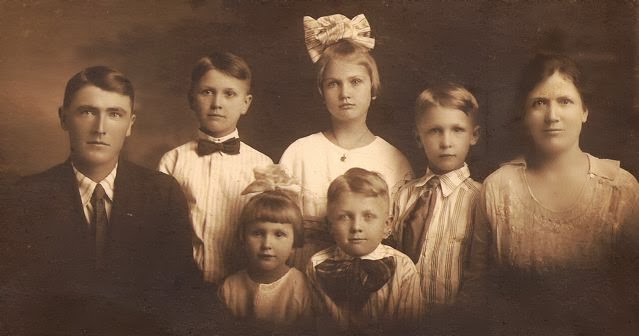“A generation goes and a generation comes, but the earth remains forever” (Ecclesiastes 1:4).
In the late 1980s I helped Dad compile information for a Troutman family history. When we finished, my mother asked me, “Now that you’re finished with the Troutman ancestors, will you see what you can learn about my McIntyres?” I was delighted to do it, and it’s been a different kind of adventure. Dad’s were mostly German immigrants; Mother’s were Scots. Turns out, my mother has as many or more Revolutionary War patriots as my Grandma Mary. Wish she were here today for me to share about them. But then, maybe she has met them in heaven.
With the help of a Campbell cousin in North Carolina, I learned about Aeneus Campbell (#A018526), a 5x great-grandfather. There are actually two men, father and son, with the same name, both who served in the war. The elder Campbell is the first patriot I found for my mother. He and the others are all ancestors of her mother Fannie Mae Myers: Me > Lois McIntyre > Fannie Mae Myers > Omie Allen Deal > Jane Campbell > Belt Campbell > Aeneas Campbell, Jr. (#A204644) > Aeneas Campbell, Sr.
Aeneus, Sr. was born in Scotland about 1730. Haven’t found a record for his arrival in the colonies, but he first lived in St. Mary’s County, Maryland. From there, he moved to Loudon County, Virginia about 1755 where he became the county’s first sheriff. His son Aeneus, Jr. was born in Loudon County in 1757. He also came just in time to serve the Fairfax Company as lieutenant during the French and Indian War. He bought a plantation called Raspberry Plain (it’s still there, Google it), which had a jail in the yard, a 12-foot-square brick building, conveniently located for the sheriff.(1) He also built the first courthouse and was among the first trustees of the town of Leesburg. In 1760, he sold Raspberry Plain to Thomas Mason and moved back to Maryland, and from there he served in the American Revolution. He helped raise a company of men in Frederick County called the First Maryland Battalion of the Flying Camp.(2) He is credited with raising and supplying the company at his own expense.(3)
The Flying Camp and the Maryland Battalions were heavily involved in the bloody battle of Brooklyn Heights during which Washington’s army suffered heavy casualties.(4)
Aeneus Campbell, Sr. first married Lydia (surname uncertain), who was the mother of three known children: Esther, Aeneus Jr., and Ann, as proven by descendants who submitted DAR applications. Lydia died about 1768. Later, Aeneus married Henrietta Cheney, 24 Dec 1793.(5) It’s likely that he had another wife between Lydia and Henrietta, but I haven’t seen the evidence. Input from those who have sources is welcome. Aeneus Sr. died in 1812 in Montgomery County, Maryland.
Aeneus, Jr. was born 3 October 1757 at Raspberry Plain. He served during the American Revolution as a lieutenant in the militia in Captain Harwood’s Company, Upper Battalion of Montgomery County.(6) He first married Sarah Hickman in 1778.(7) They had one known daughter, Mary born about 1781. Sarah died about 1790, and Aeneus, Jr. second married Eliza Ann Belt, 25 Feb 1791. They had nine known children: Thomas, Elijah, Humphrey, Esther, Asa, Ruth, Belt, Elizabeth, and David.(8) Aeneus, Jr. moved his family to North Carolina about 1796, as did the Belt and Turner families from Maryland, with whom the Campbells had intermarried. Aenaus Jr. died in Iredell County, NC on 15 Oct. 1828.(9)
Other men from the Maryland-to-North Carolina families from whom my mother descended—the Belt, Turner, and Dent families—also served in the Revolution. It’s a pleasure to share them with you. More to come.
 |
| Campbell cousins at grave of Aeneus Campbell, Jr., Iredell Co., NC |
____________________
1. Harrison Williams, Legends of Loudon (Richmond, VA: Garrett & Cassie, Inc. 1938), p. 102. This book may be viewed online, full text: https://www.gutenberg.org/files/38130/38130-h/38130-h.htm
2. Williams, p. 103.
3. Williams, p. 104.
4. For more on the Flying Camp and 1st Maryland Regiment: https://revolutionarywar.us/continental-army/maryland/ . Also, to learn more about the Battle of Brooklyn, see https://www.battlefields.org/learn/revolutionary-war/battles/brooklyn . Also, for an engaging account of the battle, read Patrick O’Donnell’s The Indispensables.
5. Maryland Marriages, 1655-1850, Frederick County, 24 Dec 1793, Henrietta Cheney and Aeneus Campbell, Ancestry.
6. R1627V (pension file); Archives Of Maryland, Vol 16, p 373; Archives Of Maryland, Vol 18, p 49.
7. U.S., Revolutionary War Pension and Bounty-Land Warrant Application Files, 1800-1900, David Campbell; Ancestry.
8. Ibid.
9. Ibid.









